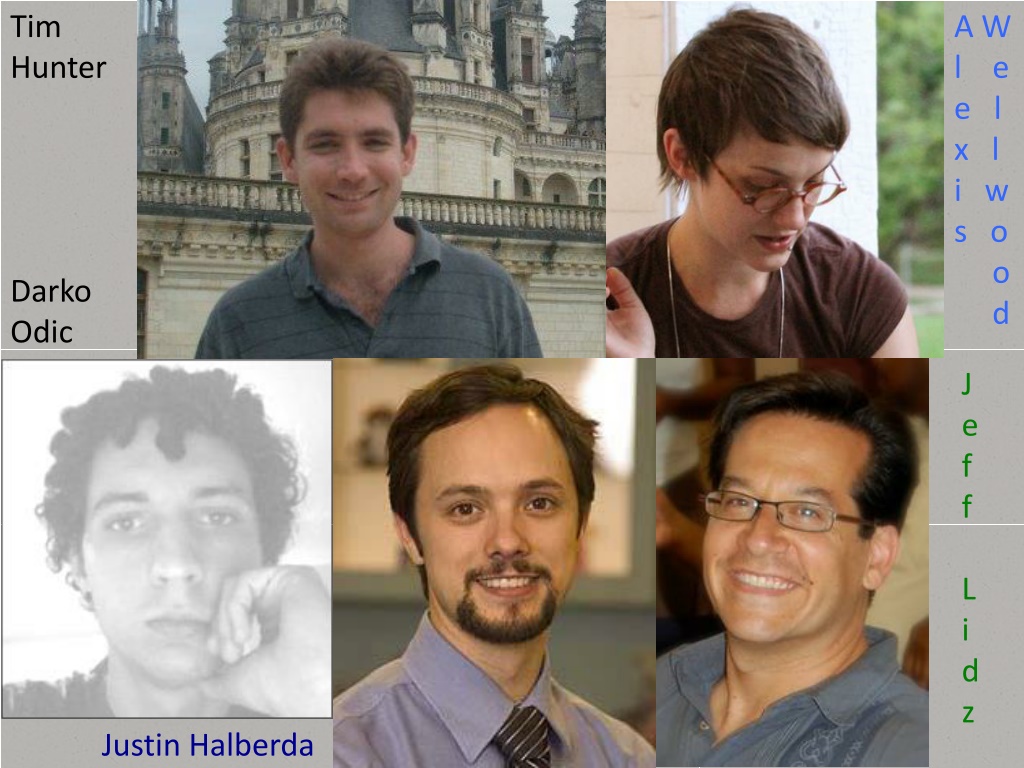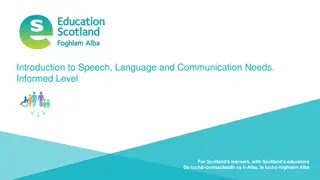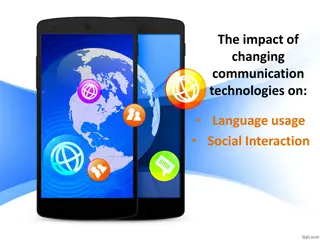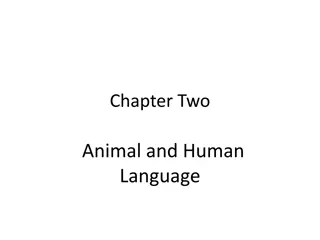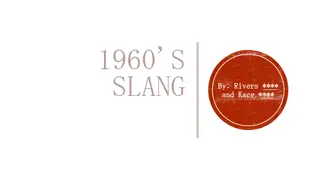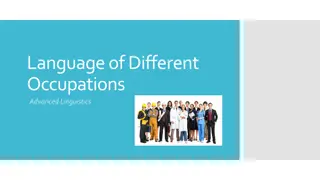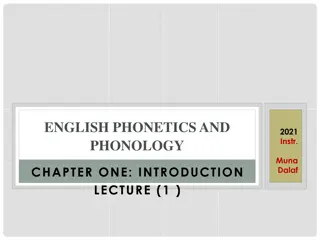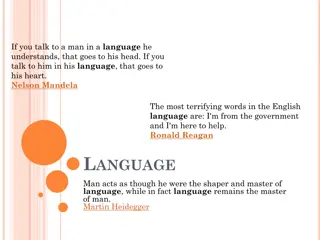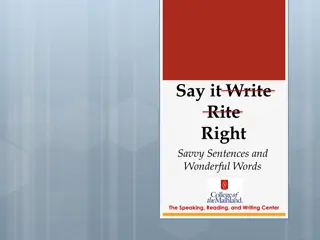Understanding Language and Slang in Human Communication
Exploring the fundamental concepts of language, slang, meanings, and their interconnections, with insights on the role of child-acquirable languages and Chomsky's I-Language theory. Discussions cover the nature of sentences, meanings, pronunciation-meaning pairs, and the generative procedures of slang as a special form of language.
Download Presentation

Please find below an Image/Link to download the presentation.
The content on the website is provided AS IS for your information and personal use only. It may not be sold, licensed, or shared on other websites without obtaining consent from the author. Download presentation by click this link. If you encounter any issues during the download, it is possible that the publisher has removed the file from their server.
E N D
Presentation Transcript
Tim Hunter A W l e e l x l i w s o o d Darko Odic J e f f L i d z Justin Halberda
a language: something that connects signals with interpretations a Slang: a language of a special sort (i) connects boundlessly many pronunciations e.g., the sounds of spoken English, or signs of ASL with boundlessly many meanings (whatever they are) (ii) acquirable by children, given ordinary experience What sort of thing is a Slang? What are the meanings that Slangs connect with pronunciations? 2
Lewis, Languages and Language What is a language? Something which assigns meanings to certain strings of types of sounds or marks. It could therefore be a function, a set of ordered pairs of strings and meanings. What is language? A social phenomenon which is part of the natural history of human beings; a sphere of human action What could a meaning of a sentence be? Something which, when combined with factual information about the world or factual information about any possible world yields a truth value. It could therefore be a function from worlds to truth-values. General conception of language as sets Slangs as special cases Meanings as sets that are independent of Slangs
A Different Picture What are Slangs? Child-acquirable languages that generate pronunciation-meaning pairs in certain (limited) ways. Languages are things of various sorts. Human Language is a hodgepodge: varied uses of Slangs. What could a sentence meaning be? Something that determines a thought, perhaps by interacting with human cognitive capacities. A sentence meaning might be a thought, and represent a truth condition. Or maybe a sentence meaning is more like an instruction (or blueprint) for how to build a thought of a certain sort. Specific conception of Slangs as generative procedures
Language: something that connects signals with interpretations Slang: a language of a special sort (i) connects boundlessly many pronunciations e.g., the sounds of spoken English, or signs of ASL with boundlessly many meanings ______________________________________________________ (ii) acquirable by children, given ordinary experience a Slang is an I-Language in Chomsky s sense: a procedure that generates pronunciation-meaning ( - ) pairs, as opposed to a mere set of such pairs 5
function in intension (computational procedure) function in extension (set of input-output pairs) |x 1| + (x2 2x + 1) { (-2, 3), (-1, 2), (0, 1), (1, 0), (2, 1), } x . |x 1| = x . + (x2 2x + 1) x . |x 1| x . + (x2 2x + 1) Extension[ x . |x 1|] = Extension[ x . + (x2 2x + 1)]
Church (1941) on Lambdas 1: a function is a rule of correspondence 2: underdetermined when two functions shall be considered the same 2-3: functions in extension, functions in intension In the calculus of L-conversion and the calculus of restricted -K-conversion, as developed below, it is possible, if desired, to interpret the expressions of the calculus as denoting functions in extension. However, in the calculus of - -conversion, where the notion of identity of functions is introduced into the system by the symbol , it is necessary, in order to preserve the finitary character of the transformation rules, so to formulate these rules that an interpretation by functions in extension becomes impossible. The expressions which appear in the calculus of - -conversion are interpretable as denoting functions in intension of an appropriate kind. 3: The notion of difference in meaning between two rules of correspondence is a vague one, but in terms of some system of notation, it can be made exact in various ways.
focus on languages as intensions: procedures that generate pronunciation-meaning pairs sets of pronunciation-meaning pairs languages as extensions: focus on might generate the same pronunciation-meaning pairs In principle, distinct procedures Extension[Language-1] = Extension[Language-2] Language-1 Language-2
(1) Bingley is eager to please #(b) Bingley is eager to be one who is pleased. (a) Bingley is eager to be one who pleases. (2) a boy saw a man with a telescope (a) A boy saw a man who had a telescope. (b) A boy saw a man by using a telescope. #(c) A boy saw a man and had a telescope. Children acquire procedures that connect boundlessly many pronunciations with boundlessly many meanings in constrained ways 9
Language: something that connects signals with interpretations Slang: a language of a special sort (i) connects boundlessly many pronunciations e.g., the sounds of spoken English, or signs of ASL with boundlessly many meanings ______________________________________________________ (ii) acquirable by children, given ordinary experience a Slang is an I-Language in Chomsky s sense: a procedure that generates pronunciation-meaning ( - ) pairs, as opposed to a mere set of such pairs 10
Slang: a child-acquirable procedure that generates boundlessly many pronunciation-meaning ( - ) pairs, What are these meanings? What are the human interpretations that Slangs connect pronunciations with? Are they more like functions-in-extension (sets), more like functions-in-intension (procedures), or neither? 11
What are Meanings? Three traditional ideas: concepts (mental representations of some sort), with thoughts as special cases of concepts extensions of ideal concepts, with truth conditions as special cases of extensions ideal concepts: concepts that have extensions extensions include sets of cats, dogs, prime numbers, ordered pairs <w, s> where s is a set of things at w ordered pairs <C, F> where C is a context and F is a set of <w, s>-pairs 12
What are Meanings? Three traditional ideas: concepts (mental representations of some sort), with thoughts as special cases of concepts extensions of ideal concepts, with truth conditions as special cases of extensions instructions of some kind for how to use pronunciations for how to build concepts of a special sort 13
What are Meanings? And do they compose? Three traditional ideas: concepts (mental representations of some sort), with thoughts as special cases of concepts extensions of ideal concepts, with truth conditions as special cases of extensions ? instructions of some kind for how to use pronunciations for how to build concepts of a special sort 14
Are most of the dots yellow? 15 dots: 9 yellow 6 blue How is the sentence understood? What question is getting asked?
Most of the dots are yellow 15 dots: 9 yellow, 6 blue MOST[DOT, YELLOW] #{DOT & YELLOW} > #{DOT}/2 More than half of the dots are yellow (9 > 15/2) #{DOT & YELLOW} > #{DOT & YELLOW} The yellow dots outnumber the nonyellow dots (9 > 6) #{DOT & YELLOW} > #{DOT} #{DOT & YELLOW} The number of yellow dots exceeds the number of dots minus the number of yellow dots (9 > 15 9)
Most of the dots are yellow MOST[DOT, YELLOW] #{DOT & YELLOW} > #{DOT}/2 #{DOT & YELLOW} > #{DOT & YELLOW} #{DOT & YELLOW} > #{DOT} #{DOT & YELLOW}
Humes Principle #{Triangle} = #{Heart} iff {Triangle} OneToOne {Heart} ____________________________________________ #{Triangle} > #{Heart} iff {Triangle} OneToOnePlus {Heart} OneToOnePlus iff for some *, * is a proper subset of , and * OneToOne (and it s not the case that OneToOne )
Most of the dots are yellow MOST[DOT, YELLOW] OneToOnePlus[DOT & YELLOW, DOT & ~YELLOW] #{DOT & YELLOW} > #{DOT}/2 #{DOT & YELLOW} > #{DOT & YELLOW} #{DOT & YELLOW} > #{DOT} #{DOT & YELLOW}
Most of the dots are yellow What conditions make the sentence easy/hard to evaluate? That might provide clues about how the sentence is understood (given independent accounts of the information available to human beings in those conditions).
Most of the dots are yellow MOST[D, Y] OneToOnePlus[{D & Y},{D & Y}] Number Representations #{D & Y} > #{D & Y} #{D & Y} > #{D}/2 #{D & Y} > #{D} #{D & Y} These analyses are provably equivalent (for finite cases) and not crazy
Most of the dots are yellow MOST[D, Y] OneToOnePlus[{D & Y},{D & Y}] Number Representations #{D & Y} > #{D & Y} #{D & Y} > #{D}/2 #{D & Y} > #{D} #{D & Y}
scattered random scattered pairs 4:5 (blue:yellow) column pairs mixed column pairs sorted
100 90 Percent Correct 80 better performance on easier ratios: p < .001 70 Scattered Random Scattered Pairs Column Pairs Mixed Column Pairs Sorted 60 50 1 1.5 2 Ratio (Weber Ratio) 10 : 15 10 : 10 10 : 20
performance on Scattered Pairs and Mixed Columns was no better than on Scattered Random looks like ANS was used to answer the question, except in Sorted Columns
but even better performance on the components of a 1-to-1-plus task if the question is notposed with most 10 : 20 10 : 10 10 : 15
Most of the dots are yellow MOST[D, Y] OneToOnePlus[{D & Y},{D & Y}] Number Representations #{D & Y} > #{D & Y} #{D & Y} > #{D} #{D & Y}
better performance on easier ratios: p < .001
fit to psychophysical model of ANS-driven performance
Most of the dots are yellow MOST[D, Y] Number Representations #{D & Y} > #{D & Y} #{D & Y} > #{D} #{D & Y}
Most of the dots are yellow MOST[D, Y] Why not take Most to be as primitive as dot and yellow seem to be? Why analyse at all? Some of the yellow dogs barked Some of the dogs barked Some of the dogs barked loudly Some of the dogs barked None of the yellow dogs barked None of the dogs barked None of the dogs barked loudly None of the dogs barked
Most of the dots are yellow MOST[D, Y] Why not take Most to be as primitive as dot and yellow seem to be? Why analyse at all? All of the yellow dogs barked All of the dogs barked All of the dogs barked loudly All of the dogs barked Most of the yellow dogs barked -- Most of the dogs barked Most of the dogs barked loudly Most of the dogs barked
Most of the dots are yellow MOST[D, Y] Why not take Most to be as primitive as dot and yellow seem to be? Why analyse at all? Most of the dogs barked More than half of the dogs barked Most of the dogs barked More dogs barked than didn t Most of the yellow dogs barked -- Most of the dogs barked Most of the dogs barked loudly Most of the dogs barked
Most of the dots are yellow What conditions make the sentence easy/hard to evaluate? That might provide clues about how the sentence is understood (given independent accounts of the information available to human beings in those conditions).
There are some yellow dots, and there are some blue dots. Many strategies that you might use to evaluate the conjunctive sentence in a particular situation, depending on the situation and relevant knowledge.
There are some yellow dots, and there are some blue dots. Many strategies that you might use to evaluate the conjunctive sentence in a particular situation. But the meaning of and invites a default strategy.
Question: & ? Background Knowledge: (1) & if and only if ( & ) v ~( & ~ ) (2) & if Tim nodded (3) & only if Tim nodded
Question: #{D & Y} > #{D} #{D & Y}? Background Knowledge: (1) #{D & Y} > #{D} #{D & Y} if and only if #{D & Y} > #{D & Y} (2) #{D & Y} > #{D} #{D & Y} if Tim nodded (3) #{D & Y} > #{D} #{D & Y} only if Tim nodded
Meanings are Verification Procedures Two ways of hearing this claim (1) What are meanings? (2) Please tell us some things about meanings. 41
Meanings are Verification Procedures Two ways of hearing this claim (1) What are meanings? Meanings are mappings from contexts to contents. Q: What are contexts? A: Mappings from indices to domain entities Q: What are contents? A: Mappings from possible worlds to truth values. Q: What are possible worlds? A: Please be quiet. I'm trying to say what meanings are. 42
Meanings are Verification Procedures Two ways of hearing this claim (1) What are meanings? Meanings are mappings from contexts to contents. Meanings are concepts. Q: What are concepts? A: Composable mental representations. Q: What are those? A: Go read all of Jerry Fodor's books. 43
Meanings are Verification Procedures Two ways of hearing this claim (1) What are meanings? Meanings are mappings from contexts to contents. Meanings are concepts. Meanings are Verification Procedures Q: What are Verification Procedures? A: Rules for connecting words with epistemically special concepts. Q: What are epistemically special concepts? A: I ll tell you later. 44
Meanings are Verification Procedures Two ways of hearing this claim (1) What are meanings? Meanings are mappings from contexts to contents. Meanings are concepts. Meanings are Verification Procedures [this often goes very badly] (2) Please tell us some things about meanings. Slangs connect meanings with pronunciations. Meanings compose. It's often said that meanings are sets Meanings provide default strategies for how to evaluate sentences as true/false 45
Most of the dots are blue What conditions make the sentence easy/hard to evaluate? That might provide clues about how the sentence is understood (given independent accounts of the information available to human beings in those conditions).
Most of the dots are blue? MOST[D, B] framing the question with most has effects that are expected if the question is understood in terms of cardinality subtraction Prima facie, this requires and a computation on this representation. #{D & B} > #{D} #{D & B} a representation of #{D} Does use of most reflect ease/difficulty of representing #{D}?
right left % Of Undergrads Who Choose This Side (N= 48) Asked, Most = 58% Asked, More = 13% Slide# 48
Which sentence would you choose to describe this picture? A) More of the dots are grey. 65% choose more B) Most of the dots are grey.
Which sentence would you choose to describe this picture? A) More of the dots are grey. 74% choose most B) Most of the dots are grey.
